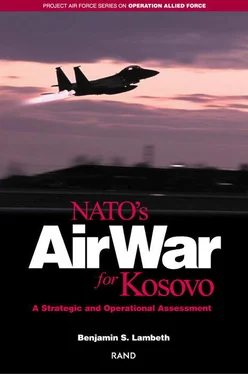AAA: Antiaircraft Artillery
AB: Air Base
ABCCC: Airborne Command and Control Center
ACC: Air Combat Command
ACTORD: Activation Order
AEF: Air Expeditionary Force
AEW: Airborne Early Warning
AFB: Air Force Base
AFSOUTH: Allied Forces Southern Europe
AFV: Armored Fighting Vehicle
AGM: Air-to-Ground Missile
AMRAAM: Advanced Medium-Range Air-to-Air Missile
AOR: Area of Responsibility
APC: Armored Personnel Carrier
ATACMS: Army Tactical Missile System
ATC: Air Traffic Control
ATO: Air Tasking Order
AWACS: Airborne Warning and Control System
AWOS: Air War Over Serbia
BDA: Battle Damage Assessment
BDI: Battle Damage Indications
C2: Command and Control
CALCM: Conventional Air-Launched Cruise Missile
CAOC: Combined Air Operations Center
CAS: Close Air Support
CBS: Columbia Broadcasting System
CBU: Cluster Bomb Unit
CIA: Central Intelligence Agency
CINC: Commander in Chief
CINCCENT: CINC U.S. Central Command
CINCEUR: CINC U.S. European Command
CINCPAC: CINC U.S. Pacific Command
CINCSOUTH: CINC Allied Forces Southern Europe
CNN: Cable News Network
CNO: Chief of Naval Operations
COMAIRCENT: Commander Allied Air Forces Central Europe
COMAIRSOUTH: Commander Allied Air Forces Southern Europe
COMUSAFE: Commander United States Air Forces in Europe
CONOPLAN: Concept of Operations Plan
CSAR: Combat Search and Rescue
DEAD: Destruction of Enemy Air Defenses
DMPI: Desired Mean Point of Impact
DMSP: Defense Meteorological Support Program
DSCS: Defense Satellite Communications System
DSP: Defense Support Program
ECM: Electronic Countermeasures
ECR: Electronic Combat Role
ELINT: Electronic Intelligence
EO: Electro-Optical
EW: Early Warning
EW: Electronic Warfare
FAC: Forward Air Controller
FLIR: Forward-Looking Infrared
FY: Fiscal Year
GAT: Guidance, Apportionment, and Targeting
GATS: GPS-Aided Targeting System
GBU: Guided Bomb Unit
GPS: Global Positioning System
HARM: High-Speed Antiradiation Missile
HMS: Her Majesty’s Ship
HTS: HARM Targeting System
HUD: Head-Up Display
IADS: Integrated Air Defense System
ID: Identification
IFF: Identification Friend or Foe
IFOR: NATO Implementation Force in Bosnia and Herzegovina
IMF: International Monetary Fund
INS: Inertial Navigation System
IR: Infrared
ISR: Intelligence, Surveillance, and Reconnaissance
JAC: Joint Analysis Center
JCS: Joint Chiefs of Staff
JDAM: Joint Direct Attack Munition
JFACC: Joint Force Air Component Commander
JTF: Joint Task Force
JTIDS: Joint Tactical Information Distribution System
JWAC: Joint Warfare Analysis Center
KEZ: Kosovo Engagement Zone
KFOR: Kosovo Force
KLA: Kosovo Liberation Army
LANTIRN: Low-Altitude Navigation and Targeting Infrared for Night
LD/HD: Low Density/High Demand
LGB: Laser-Guided Bomb
LOC: Line of Communication
MANPADS: Man-Portable Air Defense System
MEU: Marine Expeditionary Unit
MFD: Multifunction Display
MLRS: Multiple-Launch Rocket System
MSTS: Multisource Tactical System
MTI: Moving Target Indicator
MTW: Major Theater War
MUP: Serbian Interior Ministry Police
NAC: North Atlantic Council
NATO: North Atlantic Treaty Organization
NCA: National Command Authorities
NIMA: National Imagery and Mapping Agency
NPIC: National Photographic Interpretation Center
NRO: National Reconnaissance Office
OCA: Offensive Counterair
ORI: Operational Readiness Inspection
OSCE: Organization for Security and Cooperation in Europe
PACAF: Pacific Air Forces
PGM: Precision-Guided Munition
POL: Petroleum, Oil, and Lubricants
POW: Prisoner of War
RAF: Royal Air Force
RCS: Radar Cross-Section
RNLAF: Royal Netherlands Air Force
ROE: Rules of Engagement
RWR: Radar Warning Receiver
SACEUR: Supreme Allied Commander Europe
SAM: Surface-to-Air Missile
SAR: Synthetic Aperture Radar
SAS: Special Air Service
SEAD: Suppression of Enemy Air Defenses
SFOR: NATO Stabilization Force in Bosnia and Herzegovina
SHAPE: Supreme Headquarters Allied Powers Europe
SIGINT: Signals Intelligence
STARS: Surveillance Target Attack Radar System
TACAN: Tactical Air Navigation
TARPS: Tactical Air Reconnaissance Pod System
TF: Task Force
TIP: Tactical Integrated Planning
TLAM: Tomahawk Land-Attack Missile
TOT: Time on Target
UAV: Unmanned Aerial Vehicle
UCAV: Unmanned Combat Air Vehicle
UHF: Ultra-High Frequency
UN: United Nations
USA: United States Army
USAF: United States Air Force
USAFE: United States Air Forces in Europe
USAFE/SA: United States Air Forces in Europe, Studies and Analysis Office
USAREUR: United States Army in Europe
USEUCOM: United States European Command
USMC: United States Marine Corps
USN: United States Navy
USS: United States Ship
VJ: Yugoslav Army
VTC: Video Teleconference
Between March 24 and June 9, 1999, NATO, led by the United States, conducted an air war against Yugoslavia in an effort to halt and reverse the continuing human-rights abuses that were being committed against the citizens of its Kosovo province (see the Frontispiece, Map of Kosovo) by Yugoslavia’s elected president, Slobodan Milosevic. As it turned out, that 78-day effort, called Operation Allied Force, represented the third time in a row during the 1990s, after Operations Desert Storm and Deliberate Force, in which air power proved pivotal in determining the outcome of a regional conflict. Yet notwithstanding its ultimate success, what began as a hopeful gambit for producing quick compliance on Milosevic’s part soon devolved, for a time at least, into a seemingly ineffectual bombing experiment with no clear end in sight. Not only was the operation’s execution hampered by uncooperative weather and a surprisingly resilient opponent, it was further afflicted by persistent hesitancy on the part of U.S. and NATO decisionmakers that was prompted by fears of inadvertently killing civilians and losing friendly aircrews, as well as by sharp differences of opinion within the most senior U.S. command element over the best way of applying allied air power against Serb assets to achieve the desired effects. All of that and more, however unavoidable some aspects of it may have been, made NATO’s air war for Kosovo a substantial step backward in efficiency when compared to Desert Storm.
This book assesses Operation Allied Force from a strategic and operational perspective, with a view toward spotlighting what was most gratifying about the application of allied air power throughout the effort, as well as identifying and exploring aspects of air power’s performance that indicated continued deficiencies in need of attention. The analysis is based entirely on openly accessible information, enriched at various points by inputs gleaned from interviews with selected Allied Force participants at both the command and execution levels. Although the U.S. government has yet to release many of the more recondite statistics associated with the air war’s prosecution at the operational and tactical levels, more than enough confirmed information on the broader essentials has now been made public by the Department of Defense and by leading NATO officials to permit a confident reconstruction of what happened during Operation Allied Force. As in the case of the Persian Gulf War a decade ago, the principal distinguishing features of NATO’s air war for Kosovo are no longer in dispute. What remains in contention are their meaning and implications.
Читать дальше












